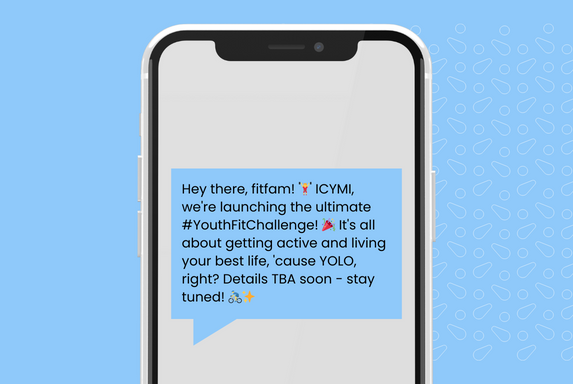Imagine yourself sitting in a café observing a group of people using abbreviations like ‘BRB’, ‘IDK’, and ‘ICYMI,’ in their text messages. Although it may appear as if they’re speaking a new language, they are actually utilizing the power of text abbreviations.
Using this ‘language’ in your communication can change how you connect with customers in today’s fast-moving world.
In this blog post, we’ve delved into text abbreviations and their usage. We’ve offered a list of common acronyms for texting and explained how to use them to improve customer experience.
Table of contents
- What are text abbreviations?
- When did text abbreviations start appearing?
- Common text abbreviations and their meanings
- Why do text abbreviations matter to businesses?
- How to use text abbreviations in customer communication?
- How do text abbreviations help in business expansion?
- How can businesses effectively use text abbreviations?
- Challenges of using text abbreviations and how to avoid them
- FAQs on using text abbreviations
- Reach out to your customers with Birdeye Messaging
What are text abbreviations?
Text abbreviations, also referred to as ‘texting abbreviations’ or ‘text acronyms,’ are short forms of words or phrases used in SMS, social media, forums, and other online platforms.
These concise expressions can be useful when you want to summarize lengthy ideas or phrases with just a few characters. But have you ever wondered what led to the birth of these texting acronyms?

When did text abbreviations start appearing?
The Internet and online messaging have made communication faster and more convenient. But in the past, people had to save space when texting because there were limits on characters and each message cost money.
This need eventually gave birth to many abbreviations designed to express a particular sentiment in a compact form.
Time went by, and these abbreviated terms became important in our daily online conversations.
Common text abbreviations and their meanings
Before delving deeper, let’s familiarize ourselves with a few popular texting acronyms:
- BRB: Be Right Back
- TBA: To Be Announced
- FYI: For Your Information
- LOL: Laugh Out Loud
- TBD: To Be Determined
- IMO/IMHO: In My Opinion/In My Humble Opinion
- IDK: I Don’t Know
- B2B/B2C: Business-to-Business/Business-to-Consumer
- FAQ: Frequently Asked Questions
- DM: Direct Message
- ETA: Estimated Time of Arrival
- EOD: End of Day
- ROI: Return on Investment
- CTA: Call to Action
- CRM: Customer Relationship Management
- UGC: User Generated Content
- KPI: Key Performance Indicator
- BFF: Best Friends Forever (Useful in loyalty programs or campaigns)
- ICYMI: In Case You Missed It
- YOLO: You Only Live Once (Effective in limited-time offer promotions)
While the list is extensive, these are a good starting point.
Why do text abbreviations matter to businesses?
You can use certain texting abbreviations for your business text messaging strategy. Here are a few vital aspects that make them critical for businesses:
1. Concise communication
Online platforms such as X (previously known as Twitter) have implemented character limits for posts. These limitations can be annoying when there is so much to be said. This is when acronyms for texting come in handy. They allow users to put it all concisely, ensuring that the message is clear.
2. Modern engagement
Texting abbreviations can help you connect well with the younger audience. While the essence of your message remains the same, it adds some sparkle that appeals to the youth.

3. Speedy responses
Quick replies are one of the important elements of increased customer satisfaction. By using text abbreviations, you can speed up conversations and ensure that your customers do not wait for long to get their queries resolved.
4. Building relatability and trust
Incorporating appropriate acronyms for texting in business communications can portray your brand as relatable. It will make your customer interactions more personal and less robotic.
How to use text abbreviations in customer communication?
Knowing when and how to utilize text abbreviations is not just about following a trend. It’s also about ensuring that your messages are complete and effective. Let’s take a look at how to incorporate them into your communication strategy:
1. Understanding your audience
It’s important to understand your intended audience. If your business targets young customers, they may like it if you use common text acronyms in your customer communications.
If your audience is diverse, prioritize clarity instead of using abbreviations. After all, it’s not about fitting in; it’s about making sure you’re understood.
2. Maintain your brand’s voice
Consider your brand as a person. Just like individuals have their own way of speaking, so does your brand.
Using abbreviations like ‘BRB’ or ‘IMO’ in messages seems appealing. But before you jump on the bandwagon, ask yourself if it truly suits your brand’s identity. You need to keep your brand’s voice consistent, even if you use text abbreviations in your conversations.
3. Prioritize clarity over brevity
Saving space and time is the primary advantage of using acronyms in text communication. However, it’s important to find the balance.
If some people might not understand an abbreviation, it’s better to write the whole word for them. Remember, it is the clarity of your message that holds more importance than being excessively concise.
Manage conversations from a single inbox
Harness the power of text abbreviations in your communications with Birdeye.
Here are a few real-life examples:
Wrong approach Customer: "Can you tell me about your return policy?" Business: "TBD. DM us!" Here, the customer may not understand 'TBD' (To Be Determined) and may want the business to take their question seriously. Right approach Customer: "When is the sale ending?" Business: "The sale's end date is TBA! Stay tuned for updates." Here, using 'TBA' (To Be Announced) makes sense and keeps the clarity of the message intact.
How do text abbreviations help in business expansion?
Text abbreviations are beyond being a trendy way of communication. They can be a key contributor to your business’s growth. Here’s how:
1. Prompt and efficient communication
We often get frustrated when businesses respond slowly to our queries in customer messaging. Utilizing texting acronyms in such cases can expedite replies, leading to improved customer satisfaction.
2. Effective SMS marketing
By using abbreviations while promoting, you can ensure that your messages are concise yet compelling.
For instance, customers would likely skim through a lengthy text about a sale. But a short message featuring phrases like “Limited-time offer” or “BOGO sale” is more likely to grab their attention.

3. Revive your brand
Utilizing text abbreviations in your messages indicates that your brand keeps up with the latest communication trends. It tells your customers that you are up-to-date and easy to connect with.
How can businesses effectively use text abbreviations?
Texting acronyms not only appeal to millennials, but they also have a significant impact on the business world as well. Let’s dive into a few real-world scenarios where they come into play:
1. Customer support
When dealing with customer inquiries through chatbots or live chat, text abbreviations can streamline conversations by making them faster and more efficient.
Example:
Customer: “When will my order arrive?”
Business: “Your order’s ETA is tomorrow by 5 PM.”
2. Marketing campaigns
SMS marketing campaigns, email subject lines or social media posts can benefit from concise yet catchy text abbreviations.
Example:
SMS: “ICYMI, our summer sale is on! Shop now & embrace the YOLO spirit.”
3. Business reporting
When communicating with internal teams for reports or quick updates, abbreviations can help condense information effectively.
Example:
Email to the team: “The ROI on our latest campaign exceeded expectations. Detailed analysis by EOD.”
4. Engaging with the community
Companies can connect with their target audience on a personal level by using text abbreviations on platforms like X or Instagram.
Example:
Tweet: “Exciting things coming your way. Announcement TBA soon. Stay tuned!”
5. Sales and promotions
You can use specific abbreviations to create a sense of urgency or exclusivity during sales events.
Example:
Ad banner: “Exclusive BFF sale! Limited stock. Shop now.”
Challenges of using text abbreviations and how to avoid them
While there are several advantages to utilizing text abbreviations, it’s important to be aware of pitfalls as well:
- Misinterpretation: There are certain abbreviations with multiple meanings. Therefore, you must ensure that the context is clear to avoid any confusion.
- Overuse: Don’t overload your customer communication with texting acronyms. Use them judiciously to make your messages look professional.
- Forgetting your audience: Always keep your audience in mind while using text acronyms. There is a chance that older customers may not appreciate texting abbreviations as much as millennials do. Therefore, make a habit of customizing your communication.
In this era of digital communication, text abbreviations offer a unique blend of efficiency and modernity. For local business owners, it’s an excellent opportunity to enhance their interactions by understanding and effectively bringing these abbreviations into play.
FAQs on using text abbreviations
Text abbreviations are more than just fashionable digital slang. These are functional roles designed to ease communication, fasten it, and align it with the modern generation. To businesses, it means quicker customer service, improved marketing messages, and a contemporary brand image.
It’s all about maintaining a balance and having a context. Excessive use of text abbreviations or their misuse might seem unprofessional. However, if used sensibly in the right context, they can make a brand look approachable and modern.
Think about your audience and the platform you’re planning to use. For instance, you can use abridgments like ‘u’ instead of ‘you’ or ‘grt’ in place of ‘great’ when communicating with millennials through tweets or SMS campaigns. To ensure clear and professional messages, it is best to avoid using abbreviations in formal communications. This applies specifically to legal documents and official announcements.
Using short words for faster communication is not new and will probably continue, even if abbreviations change. In line with growing digital communication, text abbreviations will also likely increase, particularly on platforms with character limits.
Reach out to your customers with Birdeye Messaging
In this digital-first era, customers prefer seamless interactions with businesses they love, no matter what platform they use. Birdeye Messaging ensures you’re there for your customers, engaging with them on various channels from a single inbox. Say goodbye to missed customer touchpoints and elevate your service game.
Are you interested in enhancing your customer connections? Click on the banner below to discover how Birdeye can amplify your engagement.

Originally published



